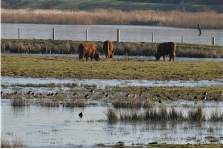

Biodiversity
Action
Plan
Wetlands – with their mosaic of standing water, reedbed, fen vegetation, and wet grassland habitats - are important for wildlife.
The string of wetlands in the Dearne Valley floodplain supports nationally important assemblages of species, including in particular breeding, passage and over-wintering birds.
Many Dearne Valley wetland sites have shallow subsistence flashes and excavated pools in seasonally flooded grassland; ditches, foot-drains and scrapes retain water within the wet grassland.
This Floodplain Grazing Marsh habitat, a mosaic of wet grassland and standing water, is important for breeding waders such as Lapwing, Redshank and Snipe, as well as overwintering wildfowl such as Wigeon and Teal.
The creation of extensive Reedbeds on some Dearne Valley sites has brought Bittern, Bearded Tit and Marsh Harrier to breed in the area, and other habitats with Fen Vegetation also support wildlife.
Priority habitats
Fen vegetation, rushes, sedges and reed grasses, is found on wet and sometimes peaty soils. It is found in floodplains, and around the margins of standing water and slow-moving water courses.
Reedbed, areas of swamp dominated by Common Reed, is a local priority habitat.
Lowland Fen and Upland flushes, fens and swamps are other priority habitats with fen vegetation.
Floodplain Grazing Marsh is a combination of wet grassland and standing water.
The best examples of these local priority habitats are sites that support good populations or assemblages of species of conservation importance.
This necessitates different management being employed to support different wildlife species.
Much of the habitat has been created from farmland although some has been used previously for railways, mining or other industries. Efforts are being made to connect the sites in a network along the Dearne Valley and beyond.
Many of the Dearne Valley wetland sites are used by the Environment Agency for flood management; the sites’ filling to capacity when the river is high and settlements are at risk of flooding.
Please use the following links for more information on wetland habitats.



Wetlands

Fen vegetation can be invasive and needs to be managed to retain the essential features required by wildlife species and to prevent valuable habitat nearby being lost.
Dearne Valley Wetlands becomes SSSI in 2021
The Dearne Valley wetlands sites are the result of projects over the last three decades to create and manage sites for nature conservation. They have been designated in May 2021 as a Site of Special Scientific Interest (SSSI).